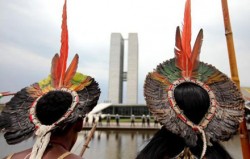 Indians of the Brazilian Amazon no longer suffer much from malaria, which is relatively under control in the world’s largest tropical forest, but now they are contracting illnesses common in the big cities of the “whites,” such as hypertension and dyslipidemia, an abnormal amount of cholesterol and/or fat in the blood.
Indians of the Brazilian Amazon no longer suffer much from malaria, which is relatively under control in the world’s largest tropical forest, but now they are contracting illnesses common in the big cities of the “whites,” such as hypertension and dyslipidemia, an abnormal amount of cholesterol and/or fat in the blood.
Such were the results of a Federal University of Sao Paulo study of Indians from the Khisedje ethnicity who live in Xingu Indigenous Park, an enormous complex of environmental reserves and indigenous reservations deep in the Amazon region, far from any big cities. The Indians, despite living in the jungle and preserving some of their traditions, are no longer isolated from the so-called “diseases of modernity,” researcher Suely Godoy Agostinho Gimeno told Efe.
The study, based on medical exams of 179 Indians in 2011, showed that the most frequently contracted illness at present among the Khisedjes is arterial hypertension, unlike in 1965, when the chief causes of death among that ethnicity were malaria, respiratory diseases and diarrhea.
According to the researchers, though infectious and parasitic diseases are still leading causes of death among those Indians, what have grown the most in recent years are chronic, non-contagious illnesses such as hypertension, glucose intolerance and dyslipidemia. The research showed that 10.3 percent of the Indians suffer from arterial hypertension and that worrying levels of arterial pressure are suffered by 18.7 percent of women and 53 percent of men.








